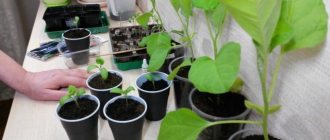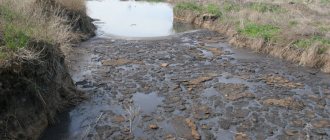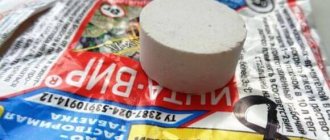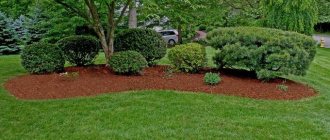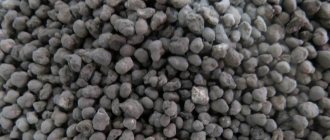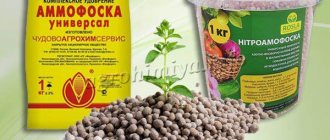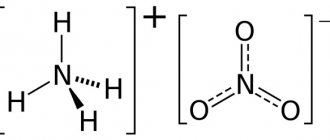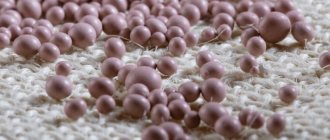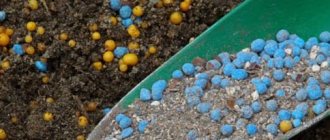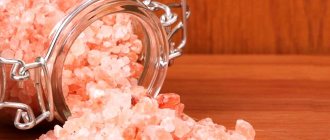At the present stage, vegetable growing can no longer manage with organic fertilizers alone. The depletion of soil and the requirements for its nutritional value in the newest hybrids and varieties lead to the increasing use of mineral substances, one of which is double superphosphate.
Let us tell you how this fertilizer differs from ordinary superphosphate and what results are achieved with its help. Let's talk about how to properly use it in the garden, in the garden and in the flower garden, taking into account the crops and some characteristics.
Differences between double superphosphate and regular superphosphate
Double superphosphate is a mineral compound that contains about 50% calcium dihydrogen orthophosphate and about 10% nitrogen. Fertilizer is the main source of phosphorus for cultivated plants, and also supplies them with a certain amount of nitrogen sufficient for the growth of green mass.
Double superphosphate does not contain gypsum; this is its main difference from regular superphosphate. In addition, double superphosphate is a concentrated fertilizer, its cost is higher, but it can also fertilize twice as large an area. Therefore, this composition is beneficial for both the seller and the gardener.
When choosing between regular and double superphosphate, you need to take into account the condition of the soil in the vegetable garden, flower bed or garden. Regular superphosphate contains gypsum, and therefore can be useful in areas with high acidity of the soil, changing its reaction towards neutral. The same effect is achieved by adding lime, but you can get by with superphosphate alone, reducing the load on the fertile soil layer.
If the results of laboratory tests reveal an increased calcium content, then it is better to use double superphosphate for fertilizer, which will bind its excess. Regular superphosphate, on the contrary, will increase the amount of this element, which is detrimental to most crops.
Double superphosphate is recommended to be used for preparing beds for planting vegetables and setting up a garden. Therefore, it is applied either in the spring or in the fall, before digging (ploughing).
According to the instructions for use, it is allowed to use double superphosphate for young plants that have not entered the flowering phase.
Sometimes double superphosphate is counterfeited. It’s easy to detect counterfeit - dilute a couple of tablespoons in a glass of water. Real fertilizer dissolves completely. If a precipitate appears, it is either ordinary superphosphate or counterfeit.
Foliar feeding
It is carried out for better absorption of nutrients by plants, as well as when a deficiency of an element is detected. Crops indicate that there is not enough phosphorus in the soil with the following symptoms:
- The leaves become small, lose turgor (elasticity), and look like withered;
- The upper side of the leaf acquires a bluish tint, the lower part of the plate turns red;
- Often the leaves curl at the edges, dry out and fall off prematurely;
- One of the characteristic signs is redness of leaf petioles and stems. They take on a red cherry hue;
- When flower buds bloom, small flowers of pale color appear. They crumble quickly. The ovary does not form well, even if it is formed, most often it immediately crumbles.
Symptoms are associated with a lack of nitrogen, because without it phosphorus cannot be absorbed.
Foliar feeding is carried out with a low concentration solution.
To quickly revive plants, they are sprayed with a solution prepared for root watering. But, they dilute its saturation three times less. That is, the base solution will need 50 g per 10 liters of water.
Treat leaves and stems from all sides in the evening.
Types of double superphosphate
In most cases, double superphosphate is a source of phosphorus and nitrogen, but does not contain additional components. However, you can find various fertilizer options on the market. Manufacturers often enhance the formula with manganese, boron or zinc. You can find a composition with molybdenum.
Their share in double superphosphate is very insignificant, usually does not exceed 2%. It is advisable to use such compositions on depleted soils, where there may be a deficiency of a number of elements. If the site is plowed virgin soil, you can use regular or double superphosphate without additional components, this will save a little money.
The most correct position is to take soil samples for analysis, then it will be clear what composition needs to be purchased.
Category: “Questions and answers”
Question No. 1. How can you correct the situation if more superphosphate was added than required?
In this case, you should not water the crops, although for a week. If the weather is too hot, then it is better to arrange shading and maintain the temperature + 220 - +250.
Question No. 2. Is it possible to add double superphosphate and ash together?
It is possible, but you need to take into account that the application rate for each type of fertilizer is halved.
Features of use in the garden
Double superphosphate is highly soluble in water; this property is used when preparing soil for planting plants or trees. The substance is scattered over the soil surface in September-October or March-April, according to the standards specified by the manufacturer, then dug up or plowed. As a result, under the influence of precipitation, double superphosphate is converted into compounds available for absorption by the plant. This is one way to apply fertilizer.
The second method involves feeding the seedlings after they have taken root in their new place. At this stage, after the formation of a root tuber, rapid growth of green mass begins, and therefore the plant especially needs phosphorus and nitrogen. Fertilizing is carried out with a solution of the drug; for this, 500 g of double superphosphate is dissolved in a bucket of water, then watered under each bush according to the instructions for use.
Consumption rates of double superphosphate for different plants:
- coniferous seedlings of the first year of life - 30-35 g when planted in a hole;
- fruit seedlings (when planting) - 200-300 g;
- planting raspberries (per 1 bush) - 40-50 g;
- potatoes, per 1 bush - 0.5-1 g;
- vegetables, including tomatoes, cucumbers, root vegetables - 10-20 g/m2.
You can prepare the soil in the fall by scattering double superphosphate over its surface before digging or plowing. In this case, the norm for cultivated land is 15-20 g per square meter, and for virgin soil - 25-30 g per square meter.
If you need to apply double superphosphate to a certain plant, for example, strawberries, but the rates are not specified, you can use a little trick. Find information on the maximum allowable dosage of regular superphosphate for this crop, and divide the number by two. This will be the feeding norm for your case.
If you use double superphosphate in its pure form, there is a risk of burning the roots or causing the accumulation of nitrates in the fruits. Therefore, experienced gardeners and gardeners do not take such risks, but mix mineral fertilizer with organic fertilizer. Well-rotted manure is ideal for this purpose, but compost will not be the best option: it does not contain much nitrogen. To prepare high-quality fertilizer, add 150 g of double superphosphate to a bucket of moistened humus and mix everything thoroughly. After 2 weeks, the fertilizer will be ready; it can be added to the holes when planting or scattered over the beds before digging.
Description
This mineral fertilizer affects all plants in several directions. The first link is an improvement in metabolism, as a result of which the level of yield will increase. The second link is improving the quality of the entire crop, thanks to the effect on the root system, as well as through improving the development and flowering process. In addition to all of the above, this product will help your plants get rid of many different diseases and slow down the aging of plants. This product is used in agriculture as fertilizer for almost all plant crops on all types of soil.
Double superphosphate is a highly concentrated water-soluble phosphorus fertilizer. It contains approximately 42-46% phosphorus, which is located in a form that is easily absorbed by all plants. In addition to the above, the composition also contains calcium sulfate, monomagnesium phosphate, aluminum phosphate, and iron phosphate. Compared to other species, the only difference is the increased content of phosphorus, which is easily absorbed. This fertilizer is used for all types and types of plants and soils. This mineral fertilizer contains a small amount of ballast substances, which in turn helps to use it with economic benefits. This type of agricultural fertilizer is introduced in early spring before planting crops.
Superphosphate contains a large number of components. The most important component is phosphorus. It accounts for approximately 20-50% of the total composition. This element is often found in the form of free phosphoric acid or in the form of monocalcium phosphate. Calcium salts of orthophosphoric acid are mixed with gypsum. Plus, salts of molybdenum, potassium permanganate, boron, and other microelements are added to all this. In addition to those mentioned above, other trace elements can also be found in the composition, such as magnesium, potassium, calcium, and sulfur. Depending on the type of fertilizer, it will contain different amounts of chemical microelements. The original mineral is created during the natural processes of mineralization of the bone composition of deceased animals.
Double superphosphate contains the same phosphorus-containing elements, but in different proportions. Outwardly, it is no different from simple superphosphate, but this type of fertilizer contains double the amount of phosphorus, here it is 45-55%. Another difference is that it does not contain gypsum. The nitrogen content ranges from approximately 14-18%. There is also about 6% sulfur. It has good friability and low hygroscopicity.
All gardeners or agricultural workers love to feed agricultural plants by watering. But fertilizers containing phosphorus are poorly soluble in water, or rather practically insoluble. To change the aggregate state of the fertilizer, it is necessary to increase the temperature of the water with which we directly dissolve the product. There are two main methods - pouring boiling water over the granules or powder, or placing the container with the solution in a warm place; in the summer, for example, you can place it in the sun. High temperatures cannot reduce the beneficial properties of the product. To create a highly concentrated solution, you need to take 300 grams of fertilizer (about 30 tablespoons) and add 3 liters of water. To grind and dissolve granules or powder, you need to periodically stir the solution. Just before watering, you will need to shake or stir the solution. In the spring, you can add about 20 mg of nitrogen fertilizer or about 500 mg of wood ash.
Both professionals and agricultural enthusiasts can purchase a variety of agrochemicals today. Due to the expanding use of soil fertilizers, several types of superphosphates have been developed, which are listed below:
- Simple or monophosphate is a slightly concentrated water-soluble fertilizer, which can be produced both in the form of powders and in the form of gray granules. The humidity in the place where it is stored should not exceed 50%. Use and apply it to any type of soil. Improves the growth of crops that require high sulfur consumption. Compared to new types of fertilizers, it has reduced efficiency, but still has found great popularity among people, as it is the cheapest. In industrial farming, it is used to fertilize potatoes, legumes, beets, carrots, cereals, and so on. It has also found its use for enriching compost pits or plant fertilizers. It has the best solubility in water compared to subsequent types.
- Granular superphosphate. This type is obtained through the process of moistening, pressing fractions and rolling into granules using industrial methods. This method exists for ease of use and storage. Has a longer effect compared to other types. It has low hygroscopicity, does not caking, is explosive and non-flammable. It contains about 50% phosphorus and about 30% calcium sulfate. It is used mainly for pre-sowing soil fertilization and as the main fertilizer.
- Double superphosphate. It contains the same phosphorus-containing components, but in a different proportion. There is almost three times more phosphorus here. Does not easily transition into a liquid state. It has one main advantage over other types. It lies in the fact that this type of fertilizer contains a small amount of ballast, which allows consumers to reduce costs for transportation, storage and packaging. Used for the application of various types of plant crops and various soils.
- Ammoniated superphosphate. This type has up to 55% potassium sulfate and about 12% sulfur. It dissolves very well in water and is easy to use. It is used mainly for feeding cruciferous and oilseed crops, which have a great need for sulfur.
Also, for the cultivation of certain plant crops, you can use other types of this fertilizer, such as those that have a high content of molybdenum, boron, and magnesium.
Tricks for using double superphosphate
Double superphosphate is a source of phosphorus and nitrogen, but different plants at different stages of growth have individual needs for these substances. Therefore, what may be suitable for a tomato will cause oppression or death for other crops. Here are just a few subtleties of using this substance:
- When sowing sunflower and corn, it is necessary that superphosphate does not have contact with the surface of the seeds - it inhibits them. It's better to make a soil layer
- Seeds of other cereals and vegetables can be mixed with granulated double superphosphate and sown in prepared holes or furrows.
- For radishes, radishes and beets, it is better to reduce the dose of fertilizer; it may even be lower than that recommended by the manufacturer.
- Peppers, eggplants, parsley and onions can grow well without double superphosphate.
- Gooseberries and currants usually also do well without phosphorus fertilizers, so if you want to feed them, the dose should be minimal.
Phosphorus is a must for all fruit trees, raspberries and strawberries. Garden crops that are favorable to this substance are pumpkin, cucumbers, tomatoes, carrots, and white cabbage. Double superphosphate will not interfere with grapes.
Sometimes it is very difficult to maintain the dosage. In the instructions for use, everything is indicated in grams; at home it is difficult to measure them accurately. The table will partly help with this.
| Capacity | Approximate quantity (g) |
| Faceted glass | 180-200 |
| Matchbox | 22-24 |
| Tablespoon | 16-17 |
| Tea spoon | 5 |
You can more or less accurately measure double superphosphate using a matchbox. If you need perfect accuracy, it is better to buy a kitchen scale for bulk products and weigh out the fertilizer with them. This method is ideal for applying fertilizer to seedlings or to each bush, when an overdose is extremely undesirable.
Double superphosphate is a concentrate, and therefore it is used in the garden plot once every 4 years. This is exactly how long phosphorus needs to completely decompose and be absorbed by plants.
First aid for plants
People who have been gardening for years know that a plant can suddenly wither. Its growth slows down, the leaves darken or acquire a purple color, and become smaller in size. If the plant survives to harvest, the fruits will be small and tasteless. These are clear symptoms of phosphorus deficiency and double superphosphate can be of great help here.
As an emergency measure, foliar foliar feeding is used, the solution for which is prepared according to the following scheme:
- bring 10 liters of water to a boil;
- add a level teaspoon of double superphosphate;
- let stand for 8 hours.
The resulting solution is filtered, poured into a sprayer and sprayed over the surface of the leaves of oppressed plants. It is advisable to do the treatment in the morning or evening to avoid causing sunburn.
Sometimes you can come across negative reviews in which the problem is clearly visible: double superphosphate does not change the situation in the garden for the better when applied to the ground. If the fertilizer is not adulterated and its expiration date has not expired, then there can only be one reason for this - increased acidity of the soil on the site. Chemical reactions also occur in it, but as a result, iron phosphate and aluminum phosphate are formed, which the plant is not able to absorb.
Therefore, on acidic soils it is better to use regular superphosphate; it contains gypsum, which alkalizes the soil. In areas with an acidic reaction, deacidification can be carried out using lime or wood ash 2 months before adding superphosphate. This will help in the future to obtain phosphorus and nitrogen compounds available for plants in the soil.
You can make mixtures with humus; they will also work excellently in such conditions.
Extract from superphosphate fertilizers
As mentioned above, phosphorus dissolves very poorly in water. But in dissolved form it reaches the roots of plants much faster. Leading gardeners have come up with a very accessible and simple way to convert phosphorus into a different state of aggregation.
This requires high temperature, so to dissolve superphosphate in water, its granules are poured with boiling water. At the same time, phosphorus retains all its qualities as a fertilizer and turns into a dispersed form that is easily digestible for plants. The container with the prepared aqueous solution should be placed in a warm place and stirred regularly. Dissolution of the granules occurs much faster, usually within 24 hours. The resulting substance looks like fatty cow's milk.
The solution is prepared in a ratio of 20 tbsp. spoons of fertilizer per 3 liters of water. This is the so-called working solution from which the main fertilizer is made. Approximately 150 grams of solution is added to 10 liters of water, as well as half a liter of wood ash and 20 grams of nitrogen fertilizer. The last component must be used, since without nitrogen phosphorus is absorbed by plants much worse.
Superphosphate fertilizers are used in early spring during the period of active growth of agricultural crops, since it is at this time that they need a large amount of nitrogen, which is easily transferred to the roots from the soil. Phosphorus arrives gradually and can act for several months in a row and even years. This microelement is not completely absorbed by plants, even in mild form. Therefore, superphosphate extract is an excellent long-term fertilizer for all agricultural plants.
Superphosphate can be dissolved in water in another way - with the help of biobacteria. For this purpose, the fertilizer is mixed with phytosporin solutions, for example, with Humate. The resulting mixture is then dissolved in water at a temperature of 20-22 °C and left for a day, stirring regularly. The solution can be used for root and near-root fertilizing of all vegetable and horticultural crops.
Differences between the two types of fertilizers
The main and serious difference between the second type of superphosphate in question and the first is the high concentration of the main component - phosphorus , which is up to 40% and higher . And also the absence of ballast in the form of calcium salt of sulfuric acid, due to which this popular fertilizer requires much less expenditure on transportation, storage and packaging.
Simple is more effective on sandy, sandy loam and podzolic soils, while double changes its composition on chernozem, and in acidic soil it is completely transformed into another compound, which is practically inaccessible to the soil.
In addition, simple has one very distinctive drawback: its physical properties are not very acceptable - it is hygroscopic, and, accordingly, it cakes quickly.
PlantsComment
When to Apply Fertilizer
The advantage of superphosphate is that it can be used at any time and at any stage of plant growth. It is suitable for autumn, spring and even summer procedures.
Use in the garden in spring
If you apply phosphate in the spring after the snow melts, the time differs in different regions, but usually the procedure is carried out in April, it is added directly to the beds when planting seedlings and seedlings. The fertilizer has minimal toxicity, so there is no need to wait a certain period before planting. Double superphosphate is poured directly into the holes for seedlings or scattered over the bed and loosened a little to cover it with soil.
The second way to use superphosphate in the spring is to water the plants with a fertilizer solution or foliar feeding. This is especially important for shrubs, fruit trees, flowers and other plants with a developed above-ground part.
Application of double superphosphate in autumn
Autumn is the best time to apply fertilizer. Usually the procedure is carried out in October, after the harvest and long frosts. The soil is still quite moist and loose. If you add it in the fall when digging the beds, then during the winter months it will have time to dissolve in the ground and take on a light form for feeding plants.
In the autumn, fertilizer is scattered evenly over the area and dug deeper at the level of the roots. The fact is that the phosphoric acid contained in it does not move in the soil, so if you don’t dig it up, it will remain on the surface and will not reach the plants. It is also added when constructing a warm bed.
Application of superphosphate in summer
Double superphosphate fertilizer can be used in summer during flowering or when fruit sets. It is also suitable for post-harvest use. In summer, either watering with a solution of superphosphate with other beneficial substances at the root or foliar feeding works best.
Bottom line
Despite the availability of innovative agrochemicals, simple superphosphate continues to be in great demand among summer residents and gardeners. It is used to fertilize seedlings throughout the growing season from early spring until autumn work. However, one should distinguish between simple and double superphosphate: the latter contains more nitrogenous substances. Nitrogen should not be added to the soil during the ripening of fruits and when preparing plants for wintering, because it activates the rapid growth of stems and leaves. In autumn and late summer, simple phosphorus powder is used for feeding.
Superphosphate is used both in pure form and in liquid solution. To qualitatively dissolve the powder and granules in water, pour boiling water over them. It is also useful to combine superphosphate with humates: they stimulate the rapid development of seedlings and facilitate the absorption of phosphorus by the root system. Compost with the addition of superphosphate is also popular: the output is an organic substrate enriched with phosphorus.
Along with agrochemicals, you can also use ordinary bone meal, rich in phosphorus and calcium. However, flour cannot completely replace superphosphate, since it has a long period of phosphorus decomposition in the soil. But combining these fertilizers will only work to your advantage: cost savings and constant enrichment with necessary microelements throughout the season.
Other phosphate fertilizers
In addition to phosphates, which are the most popular, farmers also use other fertilizers, especially when it comes to growing tomatoes. Depending on the tasks, superphosphate can be replaced with a different composition.
Table: Fertilizers with high phosphorus content
| Name | Working elements (in%) | For which crops is it suitable? |
| Ammophos | Nitrogen – 12, phosphorus – 51 | Vegetables, especially tomatoes |
| Nitroammophos | Nitrogen and phosphorus – 23 each | Slow growth of tomatoes |
| Nitroammofoska | Potassium and phosphorus – 17-19 each, nitrogen – 16 | Vegetables, flowers |
What are phosphates combined with?
Can be mixed with potassium sulfate and ammonium. The type of soil is of great importance. The granular mixture is suitable for all types of soil, but on acidified soils you need to add lime, chalk or dolomite flour - 0.5 kg per square meter, otherwise it will be difficult for the plants to receive nutrition.
suitable for deoxidation is 200 g/meter.
You also can’t overdo it with deoxidizers. The dosages specified for fertilizers must be observed. Not all plants can grow well in alkaline soils, and it will take time to restore acceptable acidity.
Simple superphosphate comes in granular and powder form. Powder is less effective, but cheaper, so many gardeners use it. Granular contains up to 50% phosphates, but is more expensive due to additional production measures.
The sulfur content in the granular substance up to 10% allows the use of superphosphate in the garden for all types of cabbage and oilseeds.
